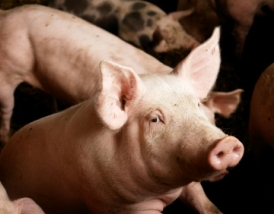Scientists aim to solve pig farm odours

Sulphurous compounds are the main source of the obnoxious smells from pig farms. Scientists from the Faculty of Agricultural Sciences at Aarhus University, Denmark, are focusing on these substances in an attempt to remove them and thus probably much of the odour currently emitted from pig houses.
Neighbours to pig farms may breathe fresher air in the future. Scientists from the Faculty of Agricultural Sciences and their collaborators have been given a sum of money from the Strategic Research Council to look into the cleansing of sulphurous compounds from vented air. The scientists are convinced that these compounds are the main source of the unpleasant smells from pig houses.
Optimising biofilter design
Biofilters have turned out to be one of the few odour-abating technologies suited to pig production. The vented air from the pig house is sent through a moist biofilm in a biofilter where the odour compounds are dissolved and subsequently decomposed by micro-organisms. The sulphurous compounds are, however, only weakly soluble in water and therefore difficult to remove. Scientists would therefore like to develop new or improve existing biofilters by investigating how the physical and chemical properties of the current filter materials affect the processes and mechanisms that are crucial to the removal of persistent compounds.
One of the aims of the project is to develop a model that enables us to optimise the biofilters. With a model it is possible to simulate a certain air flow or regulate the decomposition rate of bacteria in order to find the solutions that work best, explains PhD student Anders Michael Nielsen, Department of Agricultural Engineering.
Dust and ammonia cause problems
Part of the project focuses on removing dust and ammonia from the air before it comes into contact with the biofilters. Ammonia and dust cause problems for the biofilters. There is a lot of dust in the pig houses and it clogs up the filters, while the ammonia is converted to nitrite and destroys the biological effect of the biofilters on the odour compounds, explains senior scientist Anders Peter Adamsen.
New equipment
For this project scientists have bought a so-called PTR-MS (Proton-Transfer-Reaction Mass Spectrometer), which is a very sensitive instrument that has previously been used for measuring chemical atmospheric processes.
With the new equipment we can perform more precise online measurements of odour compounds than we have been able to before, which is important for generating the required data for the modelling part, says Anders Peter Adamsen.
The PTR-MS is used to measure the air from the pig house before and after it has been cleansed in a biofilter. This enables scientists to see the effect of the biofilter used on individual compounds. As part of the project scientists has to optimise the use of different filter materials and designs that are subsequently tested on the vented air from a pig house.
We’ve got the culprit
In four years’ time, when the project is finished, the scientists are convinced that the fight against odours from pig houses will be easier to win. “We will certainly have come a lot further than we are today and will have a lot more knowledge about the sulphurous odour compounds. We may not have removed all odours from the pig houses, but we will certainly have come a lot closer”, says Anders Peter Adamsen.
The project, titled “Cost-effective biofilters for odour nuisance abatement in pig production” is financially supported by the Strategic Research Council to the sum of DKK 11.5 million. The total budget for the project, which runs for four years from 1 January 2009, is DKK 18.1 million. Other project participants are University of Aalborg, Department of Biology at Aarhus University, Skov A/S, Danish Pig Production, and Saint-Gobain Weber A/S.
Related website
• Faculty of Agricultural Sciences, Aarhus University
©











